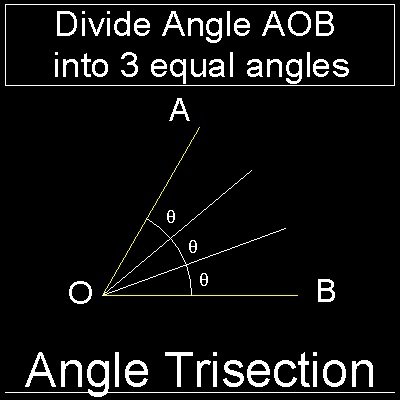
Go to Fun_Math Content Table Trisecting an Angle

To divide an "ARBITRARY" angle into three equal angles.
It is important to note that angles like 45,72, 90 & 180 degrees
can be divided into 3 equal parts by using only compass and ruler.
******** angle_trisection_problem.dwg ********
The bisection of any angle can be done easily with compass and straight-edge, but if the number
of division becomes three, Greek mathematicians encountered a difficulty.
2. The construction of a circle with center at a given point and passing through a second given point.
with ruler and compasses. But the first published proof was given by Frenchman, Pierre Wantzel (1814 - 1848), in 1837.
A very good introduction is the following web site.
Trisecting an angle
If you are looking for a book, ref(1) is the best choice. It is easy to read with brief and clear explanation.
The problem is that there are only a limited number of used books available on the market.
1. Yates,Robert C.:"The Trisection problem",first published in 1942.
2. Dudley,Underwood :"The Trisectors" The Mathematical Association of America,1994.
3. Ogilvy,Stanley C. :"Excursions in Geometry" Dover,first published in 1969
4. Dorrie, Heinrich :"100 Great Problems of ELementary Mathematics-Their History and solution", Dover 1965
The original was published in 1932.
5. Abe, Hisashi : "Amazing Origami"(In Japanese)
All questions/complaints/suggestions should be sent to takaya.iwamoto@comcast.net
Last Updated July 9-th, 2006
Copyright 2006 Takaya Iwamoto All rights reserved.